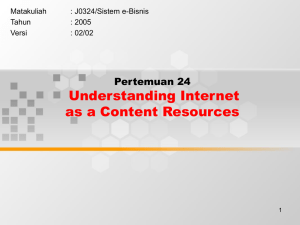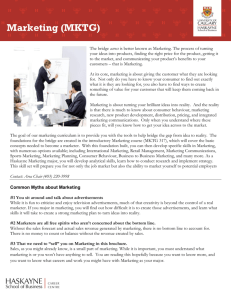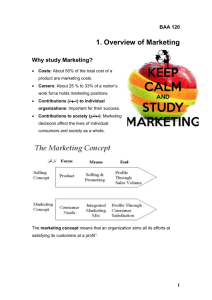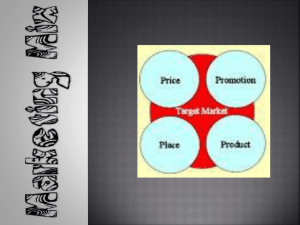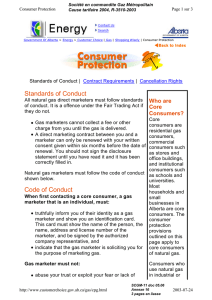Free claims - Guidance on
advertisement
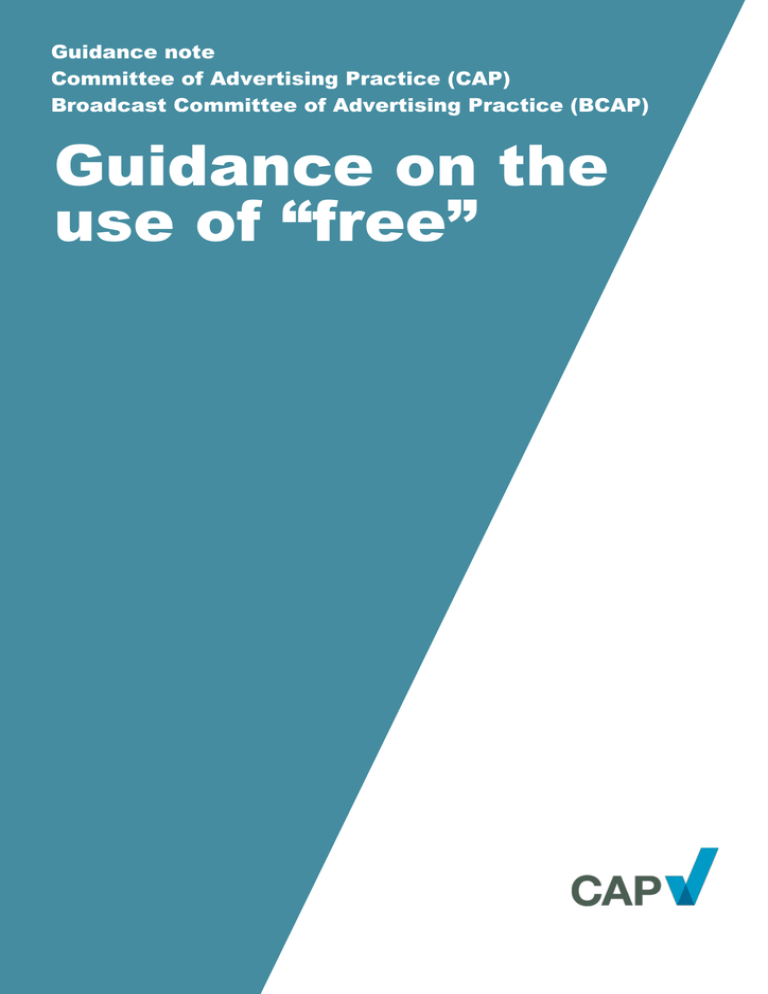
Guidance note Committee of Advertising Practice (CAP) Broadcast Committee of Advertising Practice (BCAP) Guidance on the use of “free” 1. Background 1.1 CAP and BCAP offer guidance on, respectively, the interpretation of the UK Code of Nonbroadcast Advertising, Sales Promotion and Direct Marketing (the CAP Code), in relation to nonbroadcast marketing communications, and the UK Code of Broadcast Advertising (the BCAP Code). CAP and BCAP Guidance is intended to help advertisers, agencies and media owners interpret the Codes but is not a substitute for those Codes. Guidance reflects CAP or BCAP’s intended effect of the Codes but neither constitutes new rules nor binds the ASA Councils in the event of a complaint about an advertisement that follows it. For pre-publication advice on specific non-broadcast advertisements, consult the CAP Copy Advice team by telephone on 020 7492 2100, by fax on 020 7404 3404 or by e-mail on advice@cap.org.uk. For advice on specific radio advertisements, contact the Radio Advertising Clearance Centre (RACC), www.racc.co.uk or, for TV advertisements, Clearcast, www.clearcast.co.uk. 1.2 Because similar principles apply to the use of “free” whether the claim appears in broadcast or non-broadcast advertisement, a single set of guidance is likely to be of most benefit to advertisers, agencies and media owners. 1.3 1.3 This Guidance replaces previous CAP and BCAP Help Notes on “free” claims. It is published in response to ASA adjudications on the question of whether one element of a combination of items may be described as “free”. 2. The Codes 2.1 The CAP Code states: Principle Marketing communications must not describe a product as “free”, “gratis”, “without charge” or similar if the consumer has to pay anything other than the unavoidable cost of responding and collecting or paying for delivery of the item. 3.23 Marketing communications must make clear the extent of the commitment the consumer must make to take advantage of a “free” offer. 3.24 Marketing communications must not describe items as “free” if: 3.24.1 the consumer has to pay packing, packaging, handling or administration charges for the “free” product 3.24.2 the cost of response, including the price of a product that the consumer must buy to take advantage of the offer, has been increased, except where the increase results from factors that are unrelated to the cost of the promotion, or Guidance Note Guidance on the use of “free” 2 3.24.3 the quality of the product that the consumer must buy has been reduced. CAP and BCAP have published joint guidance on the use of “free”. 3.25 Marketers must not describe an element of a package as “free” if that element is included in the package price unless consumers are likely to regard it as an additional benefit because it has recently been added to the package without increasing its price. 3.26 Marketers must not use the term “free trial” to describe “satisfaction or your money back” offers or offers for which a non-refundable purchase is required. 2.2 The BCAP Code states: Principle Advertisements must not describe a product or service as “free”, “gratis”, “without charge” or similar if the consumer has to pay anything other than the unavoidable cost of responding to the promotion and collecting or paying for delivery of the item. 3.25 Advertisements must make clear the extent of the commitment consumers must make to take advantage of a “free” offer. Advertisements must not describe items as “free” if: 3.25.1 consumers have to pay for packing, packaging, handling or administration of the “free” product or service 3.25.2 the cost of response, including the price of a product or service that consumers must buy to take advantage of the offer, has been increased, except where the increase results from factors that are unrelated to the cost of the promotion. 3.25.3 the quality of the product or service that consumers must buy has been reduced 3.26 Advertisements must not describe an element of a package as “free” if that element is included in the package price, unless consumers are likely to regard it as an additional benefit because it has recently been added to the package without increasing its price. 3.27 Advertisements must not use the term “free trial” to describe a “satisfaction or your money back” offer or an offer for which a non-refundable purchase is required. BCAP and CAP have published joint guidance on the use of “free”. 3. Types of “free” claim 3.1 Pure “free” claims “Free”, in its purest sense, means that consumers receive something for nothing: no money or other consideration, (except, if applicable, the cost of postage or carriage, non-premium rate telephone charges or reasonable travel required to collect the offer), passes from the consumer Guidance Note Guidance on the use of “free” 3 to the marketer. For example, a free product sample handed out to passers-by in a shopping centre. The use of “free” in that situation is straightforward and this Guidance will not discuss it. 3.2 Combined offers The two categories of combined offers are conditional-purchase promotions and package offers. 3.2.1 Conditional-purchase promotions The Codes allow “free” to be used if customers are required to buy other items, provided their liability for all costs is made clear and (i). the quality or composition of the paid-for items has not been reduced and (ii). the price of the paid-for items has not been increased to recover the cost of supplying the free item. The Codes explicitly allow such conditional purchase promotions. The key distinguishing feature of a conditional-purchase promotion is that the item described as "free" is genuinely separate from and additional to the item(s) that the customer is required to pay for. A free offer can be shown to be a conditional-purchase promotion in either (or both) of two ways: (i). The paid-for item(s) may be bought without the free item if preferred and has a genuine stand-alone price. The free item is capable of being sold alone, although it is not necessarily sold alone in practice (for example, subscribe to Football Weekly and you can get a free football autographed by Beckham). Consumers can always “unbundle” the free item from the paid-for item(s) and the quality, composition and price of the item being paid for will be unaffected, whether the free item is taken or not. If consumers know the price of the item(s) they are paying for without the free item, and know that the price of the paid-for item(s) remains the same if they do not take the “free” item, the offer is transparent and does not mislead consumers. (ii) The paid-for item is normally sold for the same price without the item described as “free”. The paid-for and the free item might be bundled together (for example, a free CD might be cover-mounted on a magazine or included with a newspaper inside its polythene bag; a bottle of shampoo might include 25% extra free). Even if the items cannot be unbundled, the fact that the paid-for product, without the “free” element, has an established price is enough to show that the “free” element is separate from and additional to the paid-for product. If consumers know the usual price of the element they are paying for and that it is normally supplied for that price without the “free” item, the offer is transparent and does not mislead consumers. Free conditional-purchase promotions may be run on a time-limited or channel-limited basis, or on an invariable, long-term, channel-neutral basis. But, when a customer is told that an item is "free" when another item is bought, the customer has the right to believe that the marketer will not directly seek to recover any of the cost of the free item by marking up the price of the item that has to be bought or by the substitution of inferior merchandise. Guidance Note Guidance on the use of “free” 4 Therefore, to show that an item is genuinely being supplied free, conditional on the purchase of another item, marketers must be able to show: (i). either that the free item is genuinely additional to the item(s) usually sold for that price or that the free item is genuinely separable from the paid-for item(s); (ii). that, unless the customer complies with the terms of the promotion, they do not supply the “free” item with the paid-for item(s) and (iii). that consumers are aware of the stand-alone price of the item(s) they are paying for and that that price remains the same with or without the free item. For example, assuming that the paid-for item’s quality and composition are not reduced and its price is not inflated to cover the cost of the free item: • • • • • • “free wallchart when you buy Thursday’s paper” is justified if the paper is sold without a wallchart on other days for the same price; “25% extra free”, for a bottle of shampoo, is justified if the bottle contains 25% more shampoo than is usually supplied at that price; “free travel insurance for customers who book their holiday online” is justified if customers who book the same journey by telephone are offered the same price but not offered free insurance or if internet customers who choose to buy their insurance from a different provider pay the same for their holiday as those who choose to take advantage of the marketer’s insurance offer; “free delivery for customers who spend over £50 on groceries” is justified if the retailer does not offer free delivery when the grocery spend is less than £50; “buy two books and get one free” is justified, even if the promotion is a standard longterm offer, if customers who choose to buy only two books from the marketer and not take a third book pay the same price as those who take all three books; “free internet service when you subscribe to our television service” is justified if customers who choose to buy only the television service pay the same price as those who choose to take both the television service and the separate internet service. 3.2.2 Package offers In contrast to a conditional-purchase promotion, the Codes prohibit the use of “free” to describe an element of a package if the cost of that element is included in the package price unless consumers are likely to regard it as an additional benefit because it has recently been added to the package without increasing its price (Rule 3.25). CAP introduced that extra restriction on the use of “free” in relation to packages to address concerns that marketers were advertising as “free” individual elements of packages whose cost was included in the package price. A package is a pre-arranged combination of features offered for a long-term single, inclusive price where customers cannot exercise genuine choice on how many elements of the package they receive for that price. For example: if a car is advertised with leather seats, air conditioning and a CD player for a standard price of £10,000, that combination of features is a package. The consumer pays one all-inclusive price for the car as advertised. If any of the advertised features were to be removed, the quality and composition of the car the customer is paying £10,000 for would be diminished. If he wants to claim that the CD player is free and that the £10,000 relates Guidance Note Guidance on the use of “free” 5 to the other elements, the marketer would need to demonstrate either (a) that the requirements of a conditional-purchase promotion are satisfied, or (b) that the CD player was a new additional feature and that the price of the car had not increased (see below). To take another example, a mobile-phone subscription offers a certain amount of airtime, a certain number of text messages and a voicemail facility for one all-inclusive price. Each element is intrinsic to the quality and composition of the package being advertised for the package price. Because customers cannot exercise genuine choice over how many elements they receive for the price paid, the elements are all included in the package price and may not be described as “free”. Within a package, the goods or services that are bundled together and sold for one single inclusive price could be different in nature: for example, if a single monthly subscription price is charged for a package that includes a range of television channels, access to the Internet and “free” calls to other subscribers, those services are intrinsic elements of the service that the customer is buying and, in practice, the customer has to take all three elements to pay the advertised price. Because customers cannot exercise genuine choice over how many elements they receive for the price paid, the elements are all included in the package price and may not be described as “free”. There is one exception to this. Marketers sometimes add elements to their existing packages without increasing the price of the package or reducing the quality or composition of the elements that are already included in the package. In those circumstances, consumers are likely to regard the element that has been added to the package as additional to the established package for a period after its introduction; once the element has formed part of the package for a long time, consumers are likely to regard it as a standard feature of the package. Marketers may therefore describe elements that have been added to those pre-existing packages as “free” for a reasonable period after their introduction: as a rule of thumb, marketers should avoid describing elements that have formed part of a package for more than six months as “free”. If the price of a package increases or its quality or composition is reduced after a new element is added, the new element may not be described as “free”. Some marketers argue that the availability of a “free” element of a package at a separate selling price is enough to demonstrate that the cost of that element is not included in the package price. That does not, however, justify the claim “free”. To summarise, if a package price is payable, marketers may describe elements that are included in the package as “at no extra cost” or “inclusive” but may not describe them as “free” unless they have been recently added to an established package without increasing its price. Guidance Note Guidance on the use of “free” 6 4. One-off costs For both conditional purchase promotions and packages, one-off, up-front costs incurred, for example, to buy equipment, do not negate claims that products or services supplied without subscription are “free”. For example, digital free-to-air television channels are available only to consumers who have the necessary digital receiving equipment and call packages are available only to consumers who have a telephone. Other types of one-off, up-front costs, for example connection fees payable to a third party to activate an internet service, will also not negate claims that the internet service is free, provided the price payable has not been inflated to recover the cost of supplying the free service. Marketers must ensure the requirement for such up-front payment is understood by the customer. 5. Introductory offers Marketers might want to run introductory offers for new customers, for example, “Free calls for the first three months” of a telephone call plan. Or they might want to offer a “free” incentive item with a new product, for example, “Free binder with issue one” of a magazine. 5.1 New customers of existing products When they market existing products to potential new customers, marketers can use any of the possible justifications for “free” set out above. For example, “Free sports bag for new members” of a gym would be justified if the sports bag was offered to all new members, who could choose whether or not to take it, and new members paid the same price whether or not they took the bag. The claim “Free calls for the first three months” could be justified, even on an ongoing basis where the paid-for item is a package, if the marketer showed that the offer was open only to new customers and that existing customers who paid same price did not receive inclusive calls but received an otherwise identical service; the marketer would have demonstrated that the calls were more than was usually supplied for the price and justified the use of “free”. “Free broadband for new customers of our Anytime call plan” could be justified if, for example, the marketer showed that broadband was a new feature added to a pre-existing call plan without increasing its price or reducing its quality, and that only new customers received the broadband feature. In that example, the claim would be valid only for a reasonable period after the broadband was added; after that time, because all new customers automatically receive the broadband element, consumers are likely to regard it as a standard, inclusive element of the package. (If the broadband service was automatically supplied to existing customers as well, the “free” claim would be valid but the implication that it was a special benefit for new customers would not be.) Guidance Note Guidance on the use of “free” 7 5.2 New products If the introductory offer relates to a product that has never been sold before, the marketer cannot demonstrate that the “free” item is more than is usually supplied for the price or that it has added the item to an established package without increasing the price. To justify “free” in that situation, the marketer would need to show that customers paid the same price regardless of whether they received the “free” element (that is, satisfy test (i) for conditional purchase promotions). For example, if the marketer launched a new magazine with the offer “Free binder with issue one” and showed that consumers had a genuine choice of whether they took the binder, that marketer would have shown that the offer was a conditional-purchase promotion and justified the use of “free”. November 2007 Revised: April 2009 Revised: September 2010 Guidance Note Guidance on the use of “free” 8
